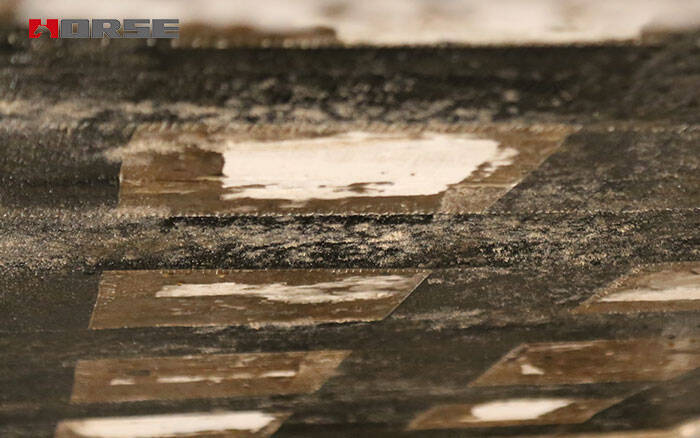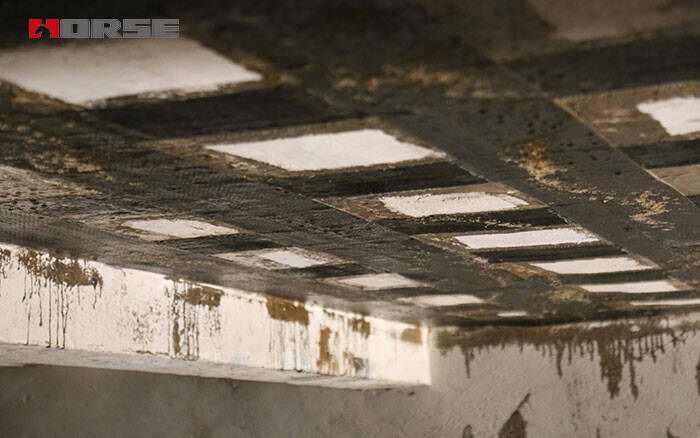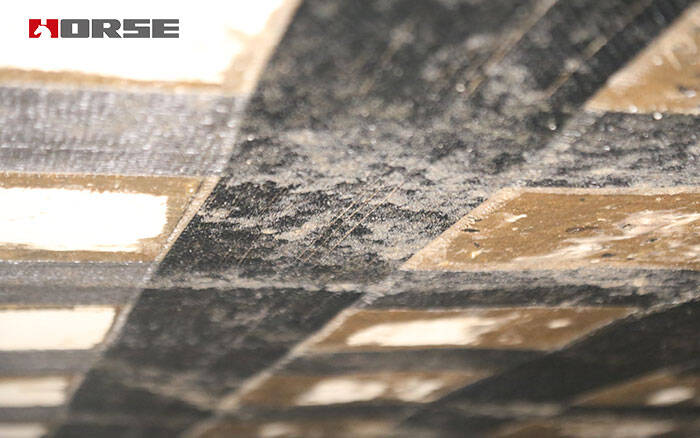Renovación de tejido de fibra de carbono
El refuerzo de fibra de carbono (CFRP) se considera el método de refuerzo estructural más prometedor debido a sus excelentes propiedades mecánicas y su alta eficiencia.
La tecnología de protección y refuerzo de estructuras de hormigón corroído ha atraído la atención mundial, y la tecnología de modernización con tejido de fibra de carbono es una de las formas efectivas de resolver este problema.

El daño por corrosión de las estructuras de hormigón armado causado por las sales es grave. La gente incluso compara el exceso grave de contenido de iones de cloruro en los componentes de hormigón armado
con el "cáncer" del hormigón. Según las estadísticas de la Oficina de Normas de Estados Unidos, la corrosión causada por la corrosión del acero de la estructura del edificio reduce la capacidad de carga, lo que hace que los elementos de hormigón armado pierdan la capacidad de carga básica provocando una pérdida de hasta 28 mil millones de dólares estadounidenses. Debido al entorno marino, la corrosión de las estructuras de hormigón armado en la zona costera es superior al 70%. Por lo tanto, la corrosión de las barras de acero, el agrietamiento por expansión, el desconchado y el desconchado del hormigón a lo largo de las barras de acero en las estructuras de hormigón armado se han convertido en los principales peligros que amenazan la durabilidad de las estructuras de hormigón armado, y las enormes pérdidas económicas que causan se han convertido en el foco de atención de los círculos de ingeniería civil.
La tecnología de protección y refuerzo de estructuras de hormigón corroído ha atraído la atención mundial, y la tecnología de refuerzo de tejido de fibra de carbono es una de las formas eficaces de resolver este problema.
1 Análisis de ejemplo de ingeniería
1.1 Antecedentes de ingeniería
El proyecto es una zona residencial en el puerto de Jingtang. Se trata de una residencia de ciudad portuaria costera con 7 estructuras de ladrillo y hormigón. Fundada en 2005, no se ha construido por alguna razón. El cuerpo principal se completó y no se decoró por dentro ni por fuera. En 2012, fue comprada por una empresa de desarrollo y estaba lista para continuar la construcción.
1.2 Detección y análisis
La construcción residencial de la zona residencial ha estado suspendida durante 7 años, lo que ha provocado muchos problemas de ingeniería. A través de la observación visual, se pueden ver manchas de óxido en la parte inferior de la losa del piso residencial por todas partes, un vacío grave, la mayor parte de la capa protectora desconchada, a lo largo de la dirección de las grietas de acero. Las vigas y las placas provocan grietas debido a la corrosión y la expansión de las barras de acero. El hormigón componente está gravemente carbonizado, el hormigón está suelto y la corrosión del acero es grave. La mayoría de las barras de acero en la parte inferior de la losa están expuestas y la sección de tensión del refuerzo está debilitada, lo que pone en peligro la seguridad de la estructura. Según los planos de diseño y el análisis de la corrosión del hormigón y las barras de acero en el lugar, y mediante la inspección de los departamentos de inspección de calidad pertinentes, se considera que el proyecto necesita ser reforzado antes de que pueda continuar la construcción.
1.3 Análisis de fallas
A través de la recolección de muchas muestras de hormigón y muestras de núcleos, mediante análisis mecánicos y químicos e investigación de campo, se extraen las siguientes conclusiones: la corrosión del acero es la principal causa del agrietamiento de la cubierta de hormigón. Por un lado, la corrosión es
causada por la intrusión de iones de cloruro en el entorno atmosférico y marino. Por otro lado, el espesor de la cubierta de hormigón no es suficiente, algunos componentes incluso no tienen capa protectora.
Resultados de la investigación de campo y de las pruebas:
La resistencia del hormigón puede cumplir básicamente con los requisitos de diseño.
Las grietas longitudinales del hormigón están conectadas longitudinalmente.
La superficie del hormigón está muy desconchada.
La corrosión de la barra de acero es muy grave y el daño de la sección de refuerzo ha alcanzado el 50%.

2 Esquema de refuerzo, construcción y control de calidad
2.1 La selección de esquemas de refuerzo se puede dividir en seis categorías: 1) método de ampliación de la sección transversal; 2) método de refuerzo de acero envolvente; 3) método de acero de unión; 4) método de refuerzo de pretensado; 5) cambio de la forma de transmisión de fuerza; 6) método de refuerzo de fibra de carbono.
La práctica ha demostrado que el método de refuerzo de fibra de carbono tiene las ventajas de alta resistencia, alto módulo, resistencia a la corrosión, resistencia a la fatiga, fácil procesamiento, peso ligero, fácil operación manual, etc. El refuerzo de fibra de carbono (CFRP) se considera el método de refuerzo estructural más prometedor debido a sus excelentes propiedades mecánicas del material y alta eficiencia.
2.2 Principio de diseño y cálculo del refuerzo de CFRP
Para mejorar la capacidad de carga, la lámina de CFRP longitudinal debe calcularse de acuerdo con el grado de corrosión de las barras de acero para reducir el área de la sección transversal de las barras de acero, la resistencia de las barras de acero y la pérdida de fuerza cohesiva entre las barras de acero y el hormigón.

3. Tejido de fibra de carbono adherido externamente sobre la estructura de hormigón
3.1 Eliminación de óxido de la barra de acero
(1) Retire el hormigón deteriorado, como desconchado, corrosión suelta y en forma de panal.
(2) Retire el hormigón de la barra de acero corroído y exponga el refuerzo.
(3) Retire la capa de óxido en la superficie de la barra de acero con un cepillo de alambre y una amoladora angular.
(4) Limpie la superficie de la barra de acero con acetona o alcohol anhidro para exponer la barra de acero.
3.2 Tratamiento de la superficie de la base,
(1) Aplanamiento de la superficie del componente, exponiendo arena, piedra y cemento.
(2) Parte de las grietas se reparan con materiales de reparación.
(3) Retire el polvo de la superficie con aire comprimido y limpie la superficie con acetona.
3.3 Cepille el pegamento de base de manera uniforme con el rodillo o brocha para cubrir la superficie del hormigón. Se requiere que se empape en el poro del hormigón y luego se proceda al siguiente
proceso después de que el pegamento se solidifique.
3.4 Tratamiento de nivelación
(1) La parte cóncava de la superficie del hormigón se llena con material de nivelación.
(2) Aplique el material de nivelación en la esquina para reparar un arco liso con un radio de no menos de 20 mm.
(3) Después de que el material de nivelación se seque, proceda al siguiente procedimiento de trabajo.
3.5 Pegado de la tela de fibra de carbono
(1) De acuerdo con el tamaño de los requisitos de diseño, se corta la tela de fibra de carbono.
(2) Prepare el adhesivo de resina de inmersión y aplíquelo uniformemente sobre la parte de la pasta.
(3) Pegue la tela de fibra de carbono, enróllela a lo largo de la dirección de la fibra varias veces con el rodillo, extruya la burbuja, de modo que el pegamento de resina se sumerja completamente en la tela de fibra de carbono.
(4) Extienda uniformemente una capa de pegamento sobre la superficie de la tela de fibra de carbono.
(5) Tenga en cuenta que la longitud de superposición del CFRP no es inferior a 100 mm, el extremo se fija con CFRP transversal y la parte deformada se repara con una jeringa.
3.6. Para garantizar la durabilidad, la resistencia al fuego y otras propiedades del adhesivo, se puede aplicar mortero o revestimiento retardante al fuego sobre la superficie para protegerla. Para cumplir con
las consideraciones del siguiente proceso (decoración de la casa), este proyecto adoptó la parte inferior del tablero con un tratamiento de lana de mortero de cemento para aumentar la adherencia de la superficie.
4 Conclusión
La nocividad de la corrosión de las barras de acero causada por la corrosión salina en las casas es un tema importante que merece la atención de los ingenieros. Es particularmente importante fortalecer la
gestión de la calidad de la construcción, controlar estrictamente la calidad del material y tomar las medidas correspondientes en vista del entorno especial. A partir del efecto de refuerzo y reparación del
proyecto involucrado en este documento, la tecnología de tratamiento de refuerzo es factible y el efecto es bueno. Después del tratamiento de refuerzo, ha pasado la aceptación del departamento de inspección
de calidad correspondiente. Se ha utilizado durante más de un año sin ninguna anomalía. El hormigón reforzado con fibra de carbono (CFRP) tiene un excelente desempeño técnico y económico, lo que
inevitablemente lo hará ocupar una posición importante en el campo del refuerzo de edificios, y tiene un buen espacio de desarrollo y perspectivas.